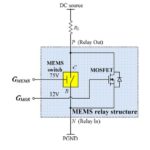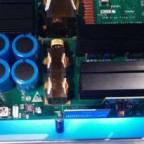Powering up odd-ball converter topologies
 ST Microelectronics had this example of a switched tank converter running in its booth, powered by one of its microcontrollers. This is a high-efficiency, high power-density topology that was described in an APEC paper by researchers at MIT and Google. In this topology, the current in the tank during each switching cycle is sinusoidal due resonance, ramping up from zero. This lets the transistors carrying the tank current turn on when current is at zero. The resonant frequency of the resonant tanks is designed to be slightly higher than the switching frequency so when the transistors are about to turn off, the sinusoidal current reverses polarity and goes through the transistor body diodes. With proper design of the dead time, the current in the body diodes ramps down to zero before the next group of transistors turn on. This action guarantees all switches turn-off when current is at zero. The prototype on display was said to accept inputs ranging from 40 to 60 V and output between 10 and 15 V while delivering 800 W peak and reach a 98.7% peak efficiency.
ST Microelectronics had this example of a switched tank converter running in its booth, powered by one of its microcontrollers. This is a high-efficiency, high power-density topology that was described in an APEC paper by researchers at MIT and Google. In this topology, the current in the tank during each switching cycle is sinusoidal due resonance, ramping up from zero. This lets the transistors carrying the tank current turn on when current is at zero. The resonant frequency of the resonant tanks is designed to be slightly higher than the switching frequency so when the transistors are about to turn off, the sinusoidal current reverses polarity and goes through the transistor body diodes. With proper design of the dead time, the current in the body diodes ramps down to zero before the next group of transistors turn on. This action guarantees all switches turn-off when current is at zero. The prototype on display was said to accept inputs ranging from 40 to 60 V and output between 10 and 15 V while delivering 800 W peak and reach a 98.7% peak efficiency.
NEXT PAGE: Power through the air






Leave a Reply